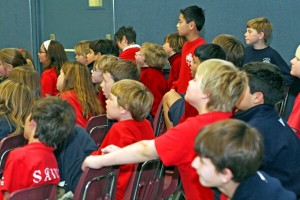 Let’s say you got the kids to settle down and your program started off with a bang. And then something happens.
Let’s say you got the kids to settle down and your program started off with a bang. And then something happens.
- A kid throws up.
- A kid keeps talking with a classmate.
- A kid shouts out.
- Adults carry on conversations.
What do you do?
I’ll give you some tips — but first, here’s a Very Important Rule:
Never Ever Embarrass a Kid or Teacher
Presume innocence. Kids and adults usually don’t realize they’re doing something annoying. Or consider that the child might have special needs (autism, Tourettes, etc.).
So, here are some strategies that might help.
A kid throws up.: This happened to me once. But the teachers and custodian were on the problem so fast, the kid was off to the nurse’s office and the spot cleaned up with barely a stir. It’s okay to acknowledge the problem and call for assistance if no one sees it happening. However, if you dwell on it, so will the kids. Show sympathy and keep on going.
A kid keeps talking with a classmate. If a kid keep chatting with a neighbor, first I stand near them and catch their eye. If that doesn’t work and they talk through my “criss-cross applesauce – hands folded on your lap” directions, I cover the microphone, bend down toward the kids and ask quietly, “Is everything okay?” This usually gets them to focus. If it doesn’t, and the chatting persists, I may quietly ask one of them to sit by their teacher.
A kid shouts out. Before I ask a question to the larger group, I’ll say, “Raise your hand if you know the answer . . .” so they know what behavior I expect. When I’m calling on volunteers to come to the stage, I say, “I need volunteers – but I’m only going to call on kids who are polite. That means, you’re sitting down, your hand is raised and your face shows me that you really, really want to be called on without calling out my name or saying ‘Oooo! Oooo!’” Showing the behavior you expect from your audience can head problems off at the pass.
Adults carry on conversations. This is going to happen. Teachers are with kids all day. When they see other adults, it’s catch-up time! They’ll usually stop chatting when you begin your presentation, but if they don’t, move close to them, as you do with the kids, and catch their eye. If they persist, you can cover the microphone and ask in a very sincere voice, “Did you have a question you wanted to ask me?” This usually works.
Finally, here’s a note about room set-up and crowd control –
In elementary schools, kids are used to sitting on the floor of the multipurpose room. I have them sit with an aisle up the middle so I can get close to as many kids as possible quickly. In middle schools and high schools however, students generally sit in an auditorium with folding seats, and organizers place speakers at a podium on the stage, far away and above the audience. But if you can break that distance and present from the floor, closer to the kids, you’ll have a much better chance of creating a bond with the audience and keeping things moving along without disruption.

Great tips. I really appreciate your “in the trenches” experience and hope I never have to deal with a child throwing up, but it is nice to know what to do in case it happens.
Let’s say a bee flies into the room (after all the children are seated and ready to listen to you) and all the children jump up and start screaming, A Bee! A Bee! This happened to me this morning. Luckily, a teacher took control, caught the bee, deported it, and the children settled down and we went on with the presentation.
When I taught elementary school in New York state, the first snow always lifted kids out of their seats and to the windows. The only thing to do was to acknowledge the event, give kids a couple of minutes to experince it, then move on. To try to ignore it wouldn’ve been madness! Same holds true for bees — except the danger factor for kids who are allergic is raised. I’m happy o hear the teacher dispatched the pollen gatherer for you!